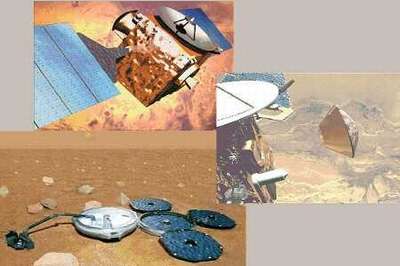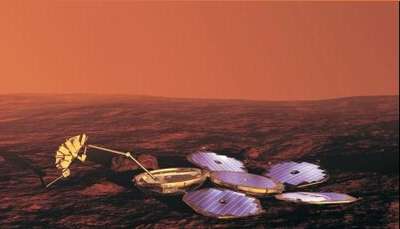Mon, Jun 02, 2003
First Ever European Visit To Red Planet
The wind stirs the dust around the former Soviet Cosmodrome at
Baikonur, in Kazakhstan. On the launch pad, a Russian-built Soyuz
rocket, tipped by a probe called "Beagle II." If all goes according
to plan, by December, the Beagle will have landed on the Martian
surface and begun looking for signs of primitive life on the Red
Planet.

An Interplanetary Mission At Bargain-Basement Prices
The European Mars mission is a study in economic space flight.
The Beagle II cost about $73 million to develop and build.
Management of the project has been largely turned over to private
industry and academia. Instead of launching the probe from the
European Space Agency's facility in South America aboard an Ariane
rocket, mission leaders decided to go to Baikonur and use the
less-expensive, more reliable Soyuz rocket. The launch will be
number 1,677 for the Soyuz program.
Total price tag for the European mission: approximately $300
million.

Red Planet - Cursed Planet?
"Mars is bad luck for space and a real difficulty for us," ESA's
science director David Southwood told Reuters. "If we were sailors,
I think we would be very superstitious about going to Mars."
Indeed, 20 of the past 30 missions to the Red Planet have ended in
something less than success. But Southwood told Reuters that
superstition won't impede the Mars Express project from putting
Beagle II on the surface. "Maybe there was life on Mars once in the
past? We are going to seek evidence of past life ... or indeed,
even micro-organisms that are alive now," Southwood said.

The European probe won't be alone in its trek to the Red Planet,
as Mars and Earth come closer than they've been for the past 66,000
years. There are two NASA orbiters circling the fourth planet and
two more NASA landers are slated for launch later this month. The
American landers contain rovers that are bigger and more
sophisticated than the UK-developed Beagle II. But only Beagle has
that onboard chemical laboratory specifically designed to look for
prehistoric signs of life.
More News
Outboard Section Of The Right Wing And The Right Flap Separated In Flight And The Airplane Impacted A Farm Field Analysis: The pilot was approaching his destination airport under i>[...]
Final Approach Fix The fix from which the final approach (IFR) to an airport is executed and which identifies the beginning of the final approach segment. It is designated on Gover>[...]
"Our choice of when to respond, how to respond and on which targets to respond is a consideration that we make every time... Netanyahu also noted that anyone attacking Israel &ldqu>[...]
Estimated (EST) When used in NOTAMs “EST” is a contraction that is used by the issuing authority only when the condition is expected to return to service prior to the e>[...]
Aero Linx: Coalition of Airline Pilots Associations (CAPA) The Coalition of Airline Pilots Associations (CAPA) is the world’s largest pilot trade association representing ove>[...]
 NTSB Final Report: Cessna 177B
NTSB Final Report: Cessna 177B ANN's Daily Aero-Term (05.08.25): Final Approach Fix
ANN's Daily Aero-Term (05.08.25): Final Approach Fix Aero-News: Quote of the Day (05.08.25)
Aero-News: Quote of the Day (05.08.25) ANN's Daily Aero-Term (05.09.25): Estimated (EST)
ANN's Daily Aero-Term (05.09.25): Estimated (EST) ANN's Daily Aero-Linx (05.09.25)
ANN's Daily Aero-Linx (05.09.25)





